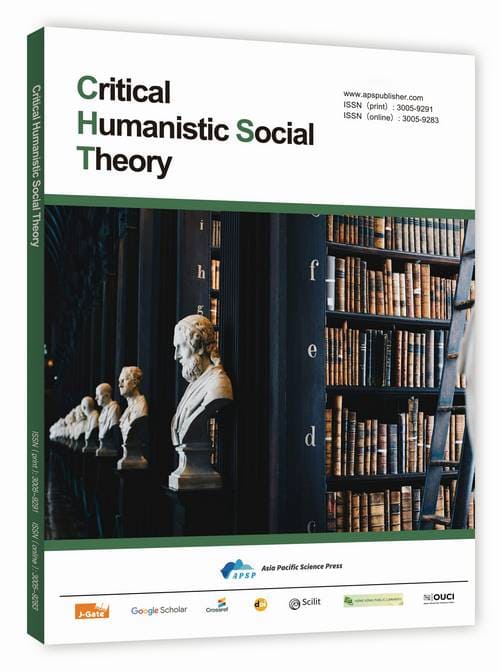The Impact of Human capital in higher education on Regional Social Science Strength
An Empirical Test Based on Panel Data from National Social Science Fund Projects Across 31 Provinces
DOI:
https://doi.org/10.62177/chst.v2i3.567Keywords:
Higher Education R&D Full-Time Equivalent Personnel, Regional Social Science Strength, National Social Science Fund Projects, Panel Data, Social Science Resource AllocationAbstract
The present study explores the impact of higher education R&D human capital on regional social science strength, with the total number of National Social Science Fund Projects (TNSSF) serving as the core measure of regional social science development. The present study utilizes panel data from 2003 to 2022, encompassing 31 Chinese provincial-level regions, to ascertain the efficacy of higher education R&D full-time equivalent personnel (RDPers) as a proxy for higher education R&D human capital input. A high-dimensional fixed-effect model is employed, supplemented by multi-method validation including endogeneity mitigation (via lagged variables) and robustness tests (placebo test, explanatory variable substitution, sample period adjustment). The results of the study indicate that: The first finding of this study indicates that the presence of Rdpers exerts a stable positive driving effect on regional social science strength. This finding is supported by a validated coefficient ranging from 0.002 to 0.004 (p < 0.01). The coefficient thus confirms Rdpers as a core driver of regional social science development. 2) A considerable time moderating effect is in evidence. Since 2007, particularly following the 2012 implementation of the "Innovation-Driven Development Strategy," the interaction coefficient between rdpers and year dummies has increased to 0.001–0.003 (p < 0.05). This is attributable to the enhancement of rdpers' role in promoting social science strength as national policies have evolved. Thirdly, marked regional heterogeneity is observed. Inter-regionally, the driving effect of rdpers follows the order "East (average coefficient=1.076) > West (0.635) > Central (0.505)." Intra-regionally, the East demonstrates stable high efficiency, the West shows polarized performance (e.g., Sichuan's coefficient=2.523 vs. Gansu's 0.542), and the Central region faces "resource mismatch" (insufficient supporting conditions for rdpers). Fourthly, among the control variables, financial support intensity (FINSUP) has a significant negative effect (-187.21, p < 0.05) due to inefficient fund use, while financial development level (FINDEV) exhibits a positive effect (19.68, p < 0.05) in recent years. This study enhances the existing body of research on the drivers of regional social science strength by substantiating the foundational role of human capital and refining the understanding of intraregional disparities. In practice, it provides empirical insights for the optimization of regional social science resource allocation (e.g., regionalized redpers allocation, reform of social science fund management) and the promotion of balanced national social science development.
Downloads
References
Chen, B., Sun, Y., Tong, Y., & Liu, L. (2024). The measurement, level, and influence of resource allocation efficiency in universities: Empirical evidence from 13 “double first class” universities in China. Humanities and Social Sciences Communications. https://doi.org/10.1057/s41599-024-03461-z
Wang, X., & Yang, J. (2025). Spatial–temporal heterogeneity and driving factors of resource allocation efficiency in regular higher education in China. Studies in Higher Education. https://doi.org/10.1080/03075079.2025.2537292
Xi, X., Zhao, Q., Liu, L., & Yang, G. (2024). Role of Educational Level in Innovation Performance: An Exploration Study of Higher Education Graduates in China. Journal of the Knowledge Economy. https://doi.org/10.1007/s13132-024-02578-5
Liang, Q., & Yin, F. (2024). Spatiotemporal Coupling of Higher Education and Economic Development in China. Sustainability, 16(16), 7198. https://www.mdpi.com/2071-1050/16/16/7198
Liu, H., & Lin, W. (2022). Uneven Innovation Geography in China: Institutional Capacity and R&D Fragmentation. Economic Geography, 98(1), 44–65.
Wang, L., & Zhao, J. (2023). R&D Input, Efficiency and Regional Knowledge Output: Evidence from Provincial Data. China Economic Review, 79, 101945.
Xu, B., & Yang, R. (2024). Incentive Mechanisms and the Transformation of University R&D in China. Research in Higher Education, 65(2), 311–328.
Xiao, S., Sheng, J., & Zhang, G. (2024). Rising tides of knowledge: Exploring China's higher education landscape and human capital growth. Journal of the Knowledge Economy, 15. https://doi.org/10.1007/s13132-024-02102-9
Luo, M., & Ye, D. (2023). Measuring the contribution of knowledge-based capital to social science productivity in Chinese universities. Higher Education Quarterly. https://doi.org/10.1111/hequ.12400
Wen, F., Yang, S., & Huang, D. (2023). Heterogeneous human capital, spatial spillovers and regional innovation: Evidence from the Yangtze River Economic Belt. Humanities and Social Sciences Communications, 10(1), 195. https://doi.org/10.1057/s41599-023-01809-5
He, Y., Li, R., & Song, H. (2022). Government R&D investment, innovation performance, and regional development: Evidence from China’s central policy reform. Economic Analysis and Policy, 74, 47–60. https://doi.org/10.1016/j.eap.2022.01.009
Zhou, Y., & Fan, Z. (2021). University research ecosystem maturity and scientific output: Regional evidence from China. Frontiers in Education, 6, 634201. https://doi.org/10.3389/feduc.2021.634201
Xiao, H., & You, J. (2021). The heterogeneous impacts of human capital on green total factor productivity: A regional diversity perspective. Frontiers in Environmental Science, 9, 713562. https://doi.org/10.3389/fenvs.2021.713562
Cheng, L., & Su, C. (2022). Institutional constraints and academic productivity in Chinese social sciences. International Journal of Educational Development, 88, 102526. https://doi.org/10.1016/j.ijedudev.2021.102526
Wang, Y., Li, Y., & Zhang, X. (2023). Misaligned incentives and inefficient R&D allocation: Evidence from subnational education funds. Asia Pacific Journal of Education, 43(2), 165–182.
Liu, Y., & Wang, T. (2022). Spatial polarization of scientific productivity across Chinese provinces: A matrix regression approach. Regional Science Policy & Practice, 14(5), 1102–1120.
Gao, M., Zhang, T., & Liu, Y. (2024). Evaluating policy-driven innovation productivity in higher education: A mediation analysis approach. Education Economics. https://doi.org/10.1080/09645292.2024.2298204
Zhang, J., & Hu, Y. (2023). From Funding to Productivity: The Moderating Role of Institutional Incentives in University R&D. Asian Journal of Innovation & Policy, 12(2), 145–169.
Downloads
How to Cite
Issue
Section
License
Copyright (c) 2025 Yile Yu, Yi Wang

This work is licensed under a Creative Commons Attribution-NonCommercial 4.0 International License.
DATE
Accepted: 2025-09-11
Published: 2025-09-19
















